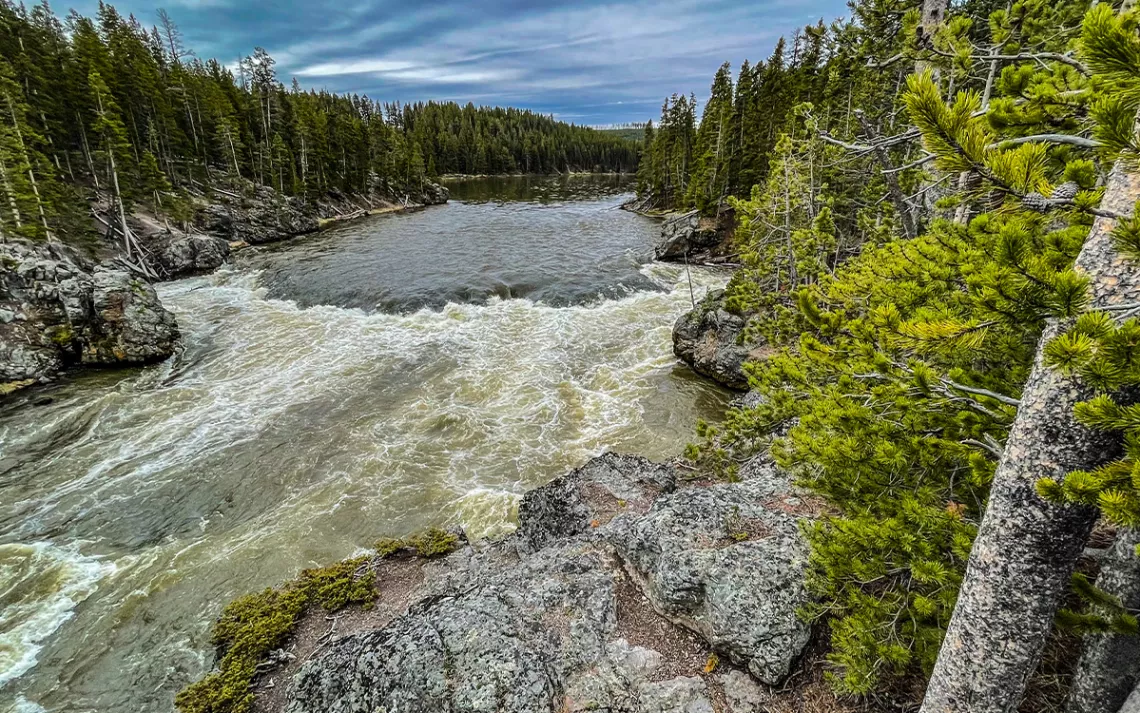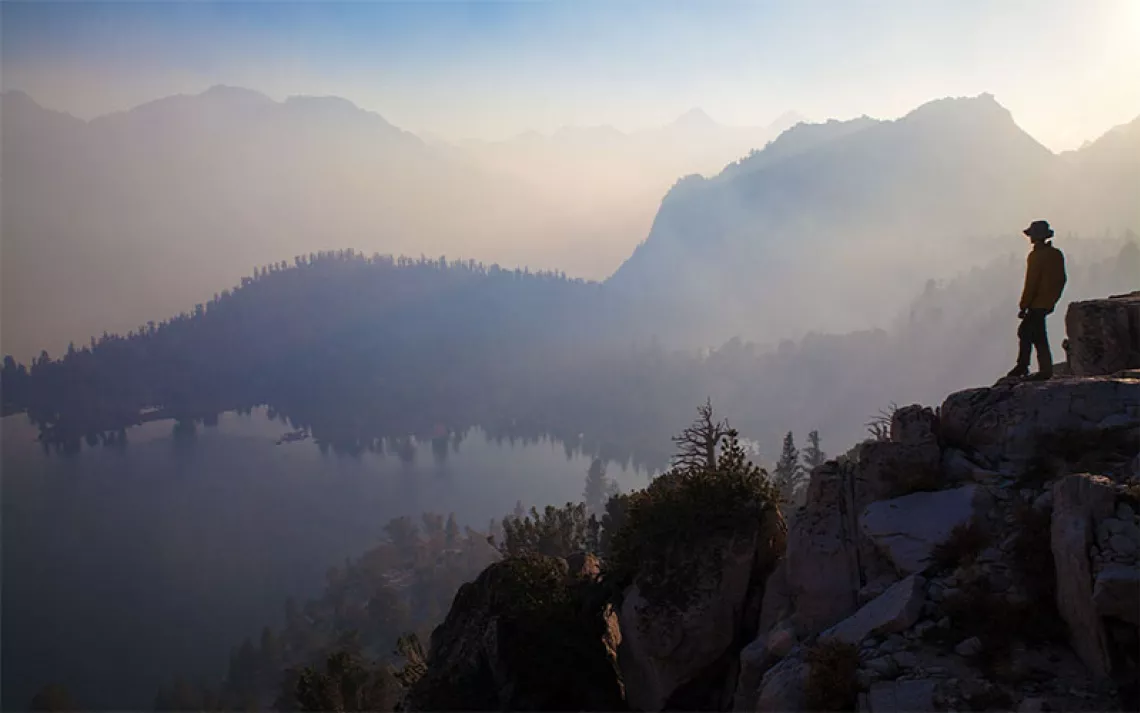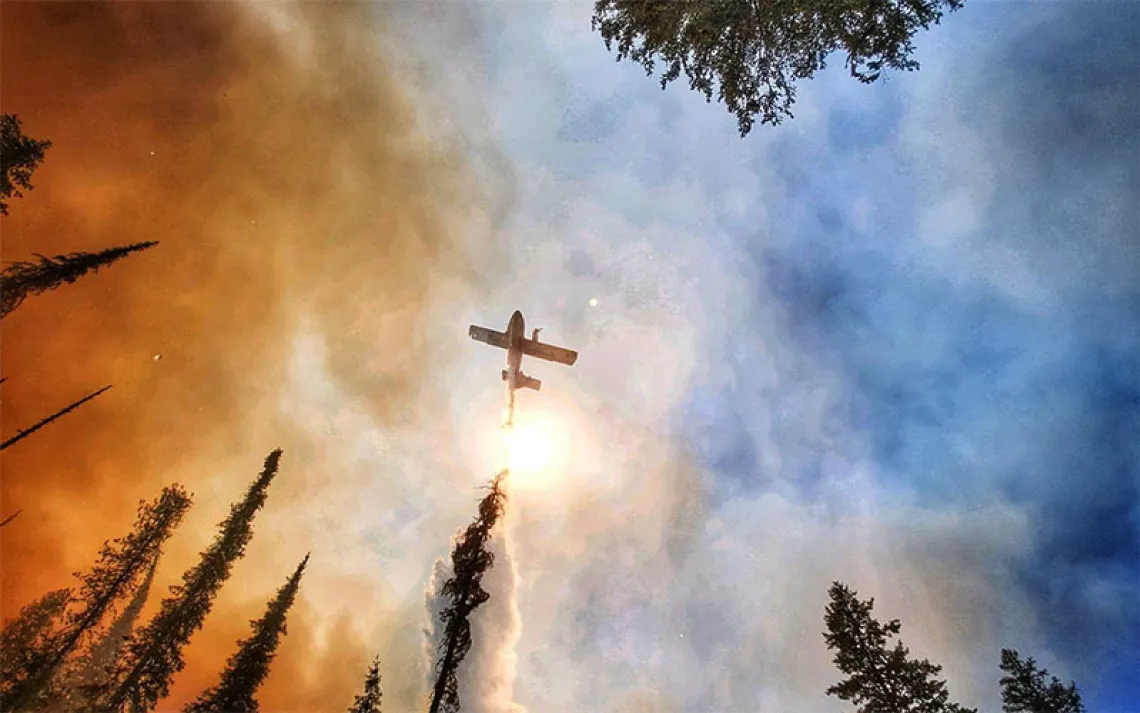What Yellowstone’s Reopening Can Teach Us About Dealing With Climate Change at National Parks
Catastrophic flooding shut down America’s first national park last summer. Since then, a lot has gone right.

Yellowstone National Park rivers prior to the floods of June 2022. | Photo by Debora Vandor/iStock
Cam Sholly woke up at 5:30 in the morning on Monday, June 13, 2022, to a barrage of text messages. It was bad news. Floodwaters were rising fast in Yellowstone National Park. Rangers had closed two of the park’s most traveled roads overnight as rocks and mud tumbled from the hills above, and now the rivers that typically meandered well below those same roads threatened to overtake them.
The road to the North Entrance was destroyed in an hour. The one to the Northeast Entrance met a similar fate soon after.
It was Sholly’s fourth summer as superintendent of Yellowstone, the park he first called home as a high schooler when his dad took a job there in the 1980s. But he’d never seen anything like this. No one had. He would eventually learn that the unrelenting rainfall and snowmelt that caused the flood and left Yellowstone’s northern reaches impassable were basically a meteorological worst-case scenario, an event so extreme it was only estimated to occur once every 500 years—at least until climate change started tipping the scales.
Sholly was responsible for making sure the thousands of people still inside the park were safe. “Our first decision, because the two northern corridors were obviously severely damaged, was to move all the visitors from the north part of the park into the south part of the park,” he said. By then, though, worrying discoveries had begun rolling in from the south, leaving him with a tough call to make. “There’s a lot of consequences that come along with shutting Yellowstone down in mid-June,” Sholly said. It’s typically the park’s third-busiest month, after July and August.
In June of 2021, Yellowstone recorded close to a million recreational visitors, a record. Before the flood, 2022 was on track to be even busier. As Sholly weighed ordering Yellowstone’s first total closure due to a natural disaster since 1988, he was keenly aware of all the travel plans and livelihoods it would disrupt. “It wasn’t a decision that I took lightly,” he said. “But in hindsight, probably one of the better decisions that we made early on was clearing the park.”
His staff shepherded roughly 12,000 people out of the southern gates over the next 24 hours without a single serious injury or death. Interior Secretary Deb Haaland—who spoke with the superintendent on the day of the flood—later told reporters at a Yellowstone press conference that she was confident Sholly’s quick action saved lives. And she praised Sholly, the National Park Service, other state and federal agencies and the contractors they hired for finding ways to reopen most of the park in a matter of weeks, minimizing disruption for tourists and keeping countless businesses in nearby towns afloat.
Most of the people who were close to Yellowstone’s recovery in the days, weeks, and months after the flood see it as a remarkable success. Few would call it an easy feat. More than a year out, as repairs continue in the park and in the hard-hit communities to its north, many are reflecting on what worked—and on what could work better—as they try to insulate themselves against future floods, fires, and everything else that could come their way.
Communication
Early reports out of Yellowstone that week were dire. Roads impassable. Bridges gone. Wastewater lines severed. For several nerve-racking days, it looked like the summer tourist season might be over before it started. Then Sholly announced that the closure would end after just nine days at the three southern entrances, where the flooding had been milder and the damage proved easier to fix.
The speed of the reopening stunned nearby residents. But it earned the endorsement of most—though not all—local officials in the southern gateway towns of Jackson, Cody, and West Yellowstone. Businesses in all three were struggling amid an onslaught of cancellations that affected bookings not only in June but through the summer and beyond. From the day the flood hit until the northern entrances were reconnected four months later, Sholly kept in near-constant communication with leaders in the towns closest to all five of Yellowstone’s gates. His strategy, from the day he took the superintendent job years earlier, had always been to “have the relationships before you need them,” he said. Those relationships came in handy last summer.
“He would call me at 10 o’clock at night,” said Tina Hoebelheinrich, who was CEO of Cody’s chamber of commerce at the time. “He was never afraid to just bounce an idea.… He absolutely understood that that road to Yellowstone was the lifeblood of Cody.”
As the floodwaters receded, the Park Service realized that initial visitation would have to be restricted to the southern half. So Sholly’s team built a reservation system—a strategy already in use at several popular national parks—to prevent traffic from overwhelming the limited infrastructure. The gateway towns, afraid that people who had already planned their trips wouldn’t be able to secure reservations, rejected the Park Service’s plan.
In a move that won him a lot of favor from those towns, Sholly didn’t force the issue. Instead, he went back to the drawing board. “Basically, I threw it out to the communities: ‘OK, what options do you want to use? We've got to have a way to modulate traffic in the park,’” Sholly said. “And a business owner in West Yellowstone offered up the alternating license plate system as an option.”
The idea harkened back to the gas-station lines of the 1970s: If your car’s license plate started with an odd number, you could enter the park on odd-numbered calendar days. If it started with an even number, you could enter on even-numbered days. There were special rules for motorcycles and exceptions for visitors staying in the park. Yellowstone officials and the surrounding towns quickly spread the word. “Honestly, everybody thought the license plate program was the craziest thing in the world,” Hoebelheinrich said. “But you know what? It cost nothing. And it got the gate open in nine days.”
On the day of the reopening, just about everyone waiting to enter the park got it right.
Efficiency
The clear directives that came from Yellowstone’s leadership during the flood were a game-changer for Xanterra, the company that runs most of the park’s hospitality operations, said Mike Keller, the general manager of its Yellowstone lodges. “When everybody's calling and wanting answers … you can get overrun very fast,” Keller said. The company started on the back foot: It had an emergency plan for wildfires and another for earthquakes, but it didn’t have a plan for flooding. It had never needed one before.
But “evacuating guests is evacuating guests,” and Xanterra adapted its fire response plan to the flood, then followed the Park Service’s directives, Keller said. “We're prepared for if there's a fire and they have to close a road or we have to evacuate a location. We have a very detailed plan in place for that. So we just kind of modified it a little bit to reflect the flood situation.”
The National Park Service has a long history of stepping up in times of crisis, said Sarah Barmeyer, managing director of conservation programs at the National Parks Conservation Association, a nonprofit that advocates on behalf of the country’s parks. The agency is used to working in rugged, remote places, and it has the tools to handle the occasional flood, fire, or hurricane. Now, though, disruptive natural disasters are becoming a near-annual phenomenon. In 2017, hurricanes devastated the Everglades and several other national parks. Flooding forced widespread closures in Mount Rainier in 2020 and a trailhead closure in 2021. The scars left by Yellowstone’s flood were still fresh when parts of Yosemite burned in 2022. Parts of Sequoia and Kings Canyon opened late this year after winter storms caused significant damage to both parks.
In some cases, Barmeyer said, the Park Service moved employees from unaffected regions to the hardest-hit parks to help with recovery. When that happens, she said, “They don’t have staff on the ground in their own parks during the busy summer season. So it's a sort of ripple effect that you see across the national park system, that if we're having these disasters that are hitting one right after another, or in different locations, there's only so much one can do at one time.”
The Department of Transportation gave Yellowstone $60 million in emergency funding 10 days after the flood, most of which the park spent on repairing the roads that could be fixed—and, when one couldn’t be, converting a 19th-century stagecoach path into a safe route for modern drivers. Congress later authorized roughly $900 million to support the park’s rebuilding efforts over the coming years.
Specialized congressional action is the standard playbook for moments when the weather wreaks havoc on national parks. It worked for Yellowstone—at least this time. “As climate change continues to impact national parks, I think what we're seeing now is only going to get worse,” Barmeyer said. “And I do worry about the strain on national park staff, and funding to deal with these issues.”
Funding
Money has always been a challenge for the Park Service. Nonurgent repair needs tend to pile up as officials wait for the money required to address them. It’s a system that can deal efficiently with really big problems but leaves parks’ infrastructure especially vulnerable to climate change in the long run.
“What we're seeing—it's above and beyond what their annual operating budgets can fix,” Barmeyer said. “We are fortunate that Congress is seeing that, and that they're giving money back to parks, but this is going to be an ongoing thing now … and then, think about these sort of Band-Aid types of funding that we're getting.”
Last year’s Inflation Reduction Act gave about $1 billion to the National Park Service, including $200 million for deferred maintenance. Much of the funding was aimed at climate resilience projects in the parks. That money has “allowed the National Park Service to think strategically across the system about where the greatest needs are, as far as staffing and facilities,” Barmeyer said. But it alone won’t be nearly enough to safeguard the 63 national parks and hundreds of other Park Service sites against the effects of climate change.
Which is why the National Parks Conservation Association wants Congress to create a more permanent source of funding for maintenance and resiliency projects. Examples might include preemptively upgrading fragile windows at hurricane-prone parks or relocating roads that face the highest risk of being swept away by floodwaters. “There’s certainly more opportunities where funding can allow for better planning ahead of time,” Barmeyer said.
The Greater Yellowstone Coalition, a conservation group based in Montana, wants Yellowstone to keep climate change top of mind as park staff decide how to use their share of Inflation Reduction Act funds and the additional $900 million from Congress. “It’s not just flood money, it’s climate money,” said Sierra Harris, the group’s climate conservation coordinator. Harris, too, is worried about what will happen as climate disasters become more frequent. The way officials handled Yellowstone’s flood gives her hope.
People living near America’s national parks have grown accustomed to construction projects taking years—sometimes many years—to move past the planning stages and secure enough funding to be built. It’s a reality the parks’ neighbors try to work around when they can and push back against when they can’t. There’s a lot of red tape. Many projects end up entangled in it.
“But when it comes to something like our beloved Yellowstone National Park, and the economy of those communities, they can get stuff done,” Harris said. “And they did.”
 The Magazine of The Sierra Club
The Magazine of The Sierra Club



